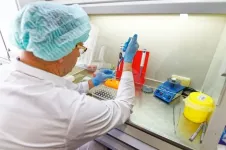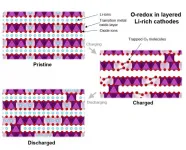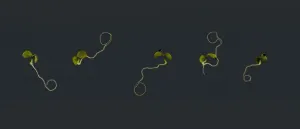(Press-News.org) The rapid loss of variation within species is a hidden biodiversity crisis, according to the authors of a new study looking at how this variation supports essential ecological functions and the benefits nature provides for people.
Published March 1 in Nature Ecology and Evolution, the study highlights the need to better understand and conserve variation within species in order to safeguard nature's contributions to people.
"Biodiversity means more than the number of species, and when we focus on species-level extinctions we are missing part of the story," said corresponding author Eric Palkovacs, professor of ecology and evolutionary biology at UC Santa Cruz. "Intraspecific variation is a neglected aspect of biodiversity, but it has value for people, and we need to start recognizing that and protecting this form of biodiversity."
An earlier study led by first author Simone Des Roches, a postdoctoral researcher at UC Santa Cruz now at the University of Washington, showed that the loss of variation within species can have serious ecological consequences. This got Des Roches and Palkovacs thinking about the broader implications of their findings for the values and services nature provides to people, from forest materials and clean water to commercial fisheries and medicines derived from natural products.
For the new study, they surveyed the scientific literature for studies showing how intraspecific variation supports ecosystem services and other aspects of nature's contributions to people. They found well documented connections across a wide variety of species, including fish and commercial fisheries, insects and crop pollination, woody plants and forestry products, many different crops and their wild ancestors, and more.
"There is a whole suite of documented cases, including several examples of what happens when we lose intraspecific variation," Palkovacs said. "One of the best examples is commercial fisheries, where diverse fish stocks help to stabilize the overall population."
Subpopulations of salmon, for example, are locally adapted to the conditions of different watersheds, allowing the overall population to remain stable even as environmental fluctuations cause declines in some subpopulations and increases in others. These "portfolio effects" in salmon are undermined by dams, which block subpopulations from critical spawning habitat, and by hatchery production, which can reduce genetic variation. The loss of intraspecific variation in salmon can lead to boom-bust population cycles that are detrimental to the long-term value of the fishery.
Des Roches noted that people have long depended on variation within domesticated and agriculturally important species. "Our coevolutionary history with hundreds of domesticated species is characterized by our continued selection for unusual and beneficial variants within species," she said. "We've often taken this too far and have thus lost critical genetic diversity in domesticated species. We depend on outbreeding with more genetically variable wild type or ancestral populations (when they exist) to restore this diversity."
Plants with medicinal value provide other well documented examples of the value of intraspecific variation, Palkovacs said. "Different varieties of the same plant species may have different compounds with different medicinal properties, such as different antimalarial drugs that depend on the genetic diversity of the plants they are derived from."
The authors emphasized the importance of collaborating with local and indigenous groups who have deep knowledge of the relationships between intraspecific variation and the natural products and services they use. "We need to take advantage of the local knowledge systems to inform our understanding of these connections," Palkovacs said.
He noted that Western science has focused overwhelmingly on species-level extinctions, and only the most well-studied groups of organisms have been characterized from the standpoint of intraspecific variation. Of all the species evaluated by the International Union for Conservation of Nature (IUCN), for example, only about 1 percent have been evaluated below the species level, and many of those show precipitous declines in diversity.
"There is strong evidence that the loss of intraspecific variation may be a very widespread problem, but we don't even know what is being lost," Palkovacs said.
There are practical steps that can be taken now, he said, to better document this variation, preserve biodiversity, and protect its contributions to the wellbeing of people. New genomic tools, for example, are available to quickly and systematically characterize the variation within species. This intraspecific variation can be directly incorporated into biodiversity assessments, such as those done by the IUCN and the Intergovernmental Science-Policy Platform on Biodiversity and Ecosystem Services (IPBES).
Addressing this aspect of biodiversity should be a major goal of global conservation efforts, the authors said. "The available evidence strongly suggests that the benefits of studying and conserving intraspecific variation will far outweigh the costs," Palkovacs said.
He noted that variation within species is the raw material of adaptive evolution. In a rapidly changing world, this variation is critically important to enable species to adapt to the conditions of an unpredictable future.
INFORMATION:
In addition to Palkovacs and Des Roches, the coauthors of the paper include environmental economist Linwood Pendleton, senior vice president for science at the Centre for the 4th Industrial Revolution, and Beth Shapiro, professor of ecology and evolutionary biology at UC Santa Cruz and a Howard Hughes Medical Institute investigator. This work was supported by the University of California and NOAA.
ITHACA, N.Y. - The expansion of charter schools in the 2000s led to an increase in school segregation and a slight decline in residential segregation, according to new research from Cornell University providing the first national estimates of the diverging trends.
According to the study, the average district to expand charter school enrollment between 2000 and 2010 experienced a 12% increase in white-Black school segregation and a 2% decrease in white-Black residential segregation.
The patterns moved in opposite directions, the research found, because charter ...
Scientists from the Stanley Manne Children's Research Institute at Ann & Robert H. Lurie Children's Hospital of Chicago found that a region within the DNA of the cancer-promoting GLI1 gene is directly responsible for regulating this gene's expression. These findings, published in the journal Stem Cells, imply that this region within GLI1 could potentially be targeted as cancer treatment, since turning off GLI1 would interrupt excessive cell division characteristic of cancer.
"From previous research, we know that GLI1 drives the unrelenting cell proliferation that is responsible for many cancers, and that this gene also stimulates its own expression," says co-senior author Philip Iannaccone, MD, PhD, Professor Emeritus at the Manne Research Institute at Lurie Children's and Northwestern ...
Scientists from Far Eastern Federal University (FEFU) together with Russian and German colleagues, continue studying antitumor compounds synthesized based on bioactive molecules isolated from a sea sponge. One of them fights cancer cells resistant to standard chemotherapy, and at the same time has an interesting dual mechanism of action. A related article appears in Marine Drugs.
Scientists have tested the biological effect of the marine alkaloid 3,10-dibromofascaplysin on various prostate cancer cells, including those resistant to standard docetaxel-based chemotherapy. ...
CORVALLIS, Ore. - In tropical oceans, a combination of sunlight and weak winds drives up surface temperatures in the afternoon, increasing atmospheric turbulence, unprecedented new observational data collected by an Oregon State University researcher shows.
The new findings could have important implications for weather forecasting and climate modeling, said Simon de Szoeke, a professor in OSU's College of Earth, Ocean, and Atmospheric Sciences and the lead author of the study.
"The ocean warms in the afternoon by just a degree or two, but it is an effect that has largely been ignored," said de Szoeke. ...
HARWELL, UK (1 March 2021) Scientists based at the University of Oxford as part of the Faraday Institution CATMAT project researching next-generation cathode materials have made a significant advance in understanding oxygen-redox processes involved in lithium-rich cathode materials. The paper, published in Nature Energy, proposes strategies that offer potential routes to increase the energy density of lithium-ion batteries.
"In the ever more difficult quest to make incremental improvements to Li-ion battery energy density, being able to harness the potential of oxygen-redox cathodes and the bigger improvements they offer relative to the nickel rich cathodes in commercial use today is potentially significant," Prof Peter Bruce, University ...
Childhood cancer and its treatment can result in cognitive struggles. Scientists atSt. Jude Children's Research Hospital are studying the risk factors. They looked at social and economic issues in children with brain tumors treated with radiation.
These patients have the greatest risk of cognitive problems. Scientists followed a group of St. Jude patients for 10 years. The children all had conformal radiation therapy.
For each patient, researchers looked at certain factors. These included the parent's job, education level, and whether it was a single parent home. The children were from different backgrounds.
The findings show social and economic status is linked to IQ, academics, attention ...
Amsterdam, March 1, 2021 - Comfort is a daily human experience central to the perception of our environment and the continuous processing of sensory input. Environmental factors such as smell, temperature and light can influence comfort, as can our interaction with products, such as the design of a chair or a mattress. Increasingly, researchers investigating the science of comfort and discomfort are focusing on the role of human behavior. A special supplement to the journal WORK presents the latest advances, from optimal seat design in offices and transportation to the influence of smell on comfort and the interaction between time and comfort.
"This special supplement adds unique findings to comfort knowledge. ...
A novel targeted immunotherapy approach developed by researchers at the Ludwig Center, the Lustgarten Laboratory, and Bloomberg~Kimmel Institute for Cancer Immunotherapy at the Johns Hopkins Kimmel Cancer Center employs new antibodies against genetically altered proteins to target cancers.
The researchers targeted their immunotherapy approach to alterations in the common cancer-related p53 tumor suppressor gene, the RAS tumor-promoting oncogene or T-cell receptor genes. They also tested the therapy on cancer cells in the laboratory and in animal tumor models. Their findings are reported in three related studies published March 1 in Science Immunology, Science and Science Translational Medicine.
Two ...
Scientists have identified that the COVID-19 virus could be transmitted through faecal contaminated river water.
A team of researchers, including water quality, epidemiology, remote sensing and modelling experts, led by Dr Jamie Shutler at the University of Exeter, have developed a fast and simple way to assess the potential risk of water-borne transmission of the COVID-19 virus, posed by sewage spills into open and closed freshwater networks.
The new study, published in the journal Environmental Science and Technology - Water, identifies the relative risk of viral transmission by sewerage spills, across 39 different counties.
The study used information on the environment, a population's infection rate, and water usage to calculate the potential potency of ...
Plants grow towards the light. This phenomenon, which already fascinated Charles Darwin, has been observed by everyone who owns houseplants. Thus, the plant ensures that it can make the best use of light to photosynthesize and synthesize sugars. Similarly, the roots grow into the soil to ensure that the plant is supplied with water and nutrients.
These growth processes are controlled by a hormone called "auxin", which plays a key role in the formation of polarity in plants. To do this, auxin is transported in the plant body polar, from the shoot through the plant body into the roots. In this process, a family of polar transport proteins distributes the auxin throughout the plant. To ...






